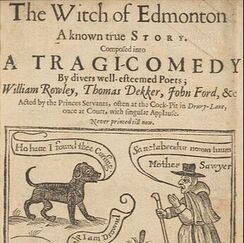Further Reading
Richard Brome and Thomas Heywood, The Late Lancashire Witches, ed. Helen Ostovich. [contains Tomkyns letter] Rachel E. Clark, “John Webster and the Height of Jacobean Tragedy.” Seventeenth Century English Literature, ed. Kirilka Stavreva. Gale Researcher Guide. Sheila Coursey, “Two Lamentable Tragedies and True Crime Publics in Early Modern Domestic Tragedy.” Comparative Drama 53, no. 3/4 (2019): 263–86. Eamon Duffy, The Stripping of the Altars: Traditional Religion in England 1400-1580. Elizabeth L. Eisenstein, The Printing Revolution in Early Modern Europe. English Broadside Ballad Archive. Marissa Greenberg, Metropolitan Tragedy: Genre, Justice, and the City in Early Modern England. Frank Kermode, The Age of Shakespeare. Harold Schechter, “Our Long-Standing Obsession with True Crime.” Creative Nonfiction, no. 45 (2012): 6–8. Emma Smith, ed., Five Revenge Tragedies. Tessa Watt, Cheap Print and Popular Piety, 1550-1640. Elizabeth Williamson, "The Domestication of Religious Objects in the White Devil." Studies in English Literature, 1500 - 1900 47, no. 2 (Spring, 2007): 473-4A. Stephen Wittek, The Media Players: Shakespeare, Middleton, Jonson, and the Idea of News. Music: "Evening Melodrama" by Kevin Macleod (www.incompetech.com)
0 Comments
Leave a Reply. |
Site Map |
© 2013-2024 Footnoting History. All rights reserved.
Footnoting History and the Footnoting History logo
are trademarks of Footnoting History, NY. Footnoting History operates under a SAG-AFTRA Micro-Monetized Podcast Agreement. |



